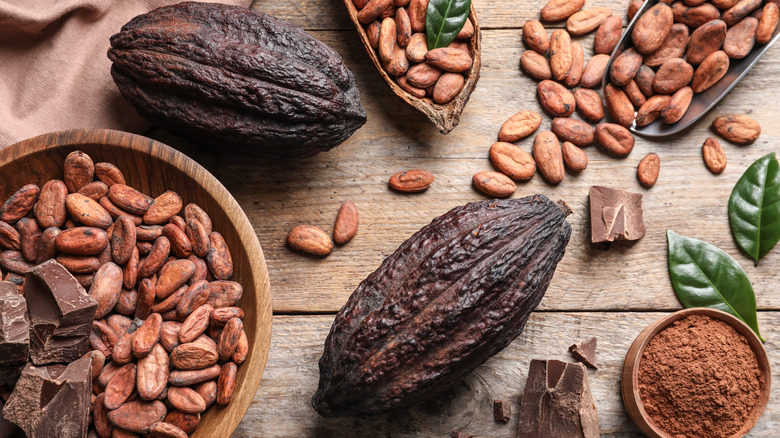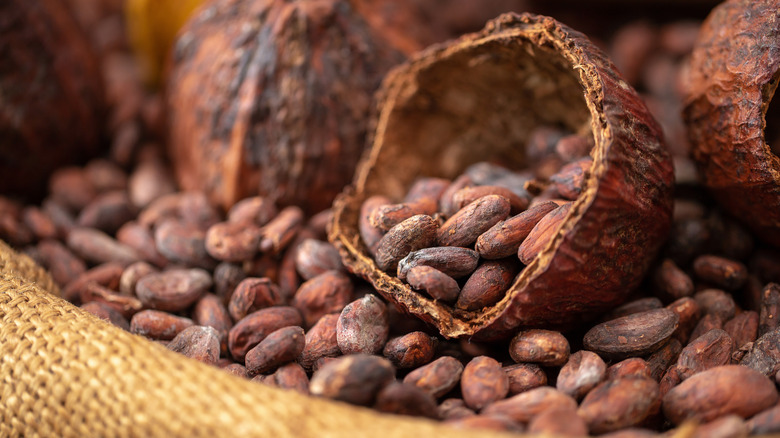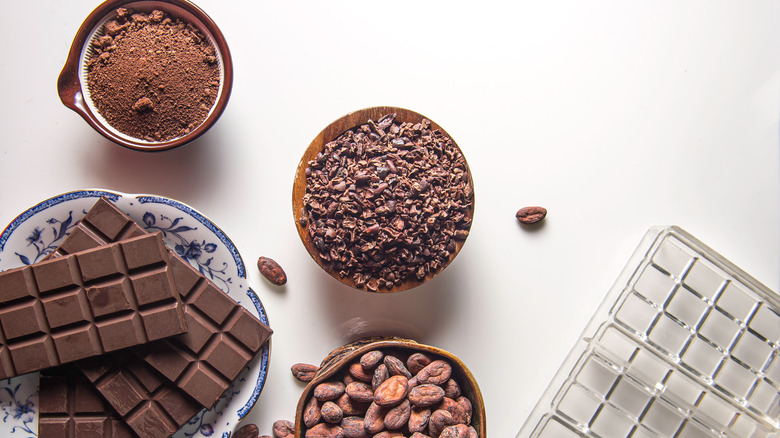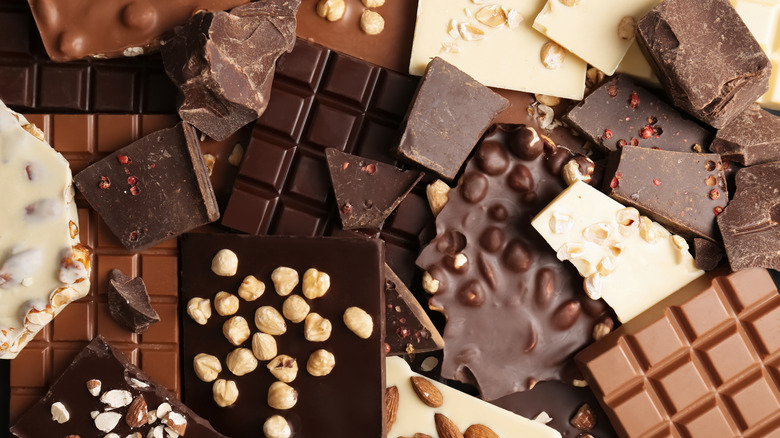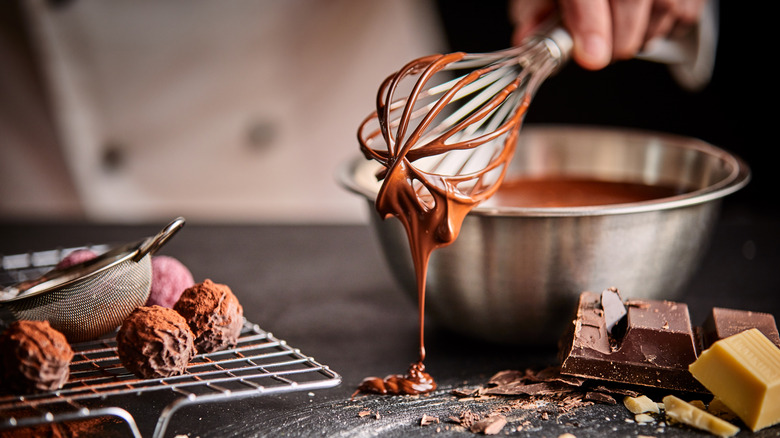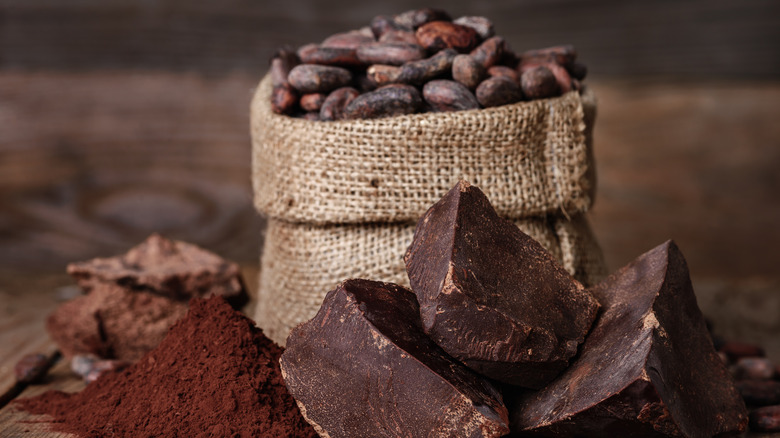Cacao Vs. Cocoa: What Makes Them Different?
We may receive a commission on purchases made from links.
If you have ever spent a minute or two browsing through the baking aisle in a grocery store, you have probably noticed bags of cocoa and cacao powder. Perhaps you have seen the terms on chocolate bars labeled with different percentages of cocoa and cacao, too. It may seem like the difference between cacao and cocoa is nothing but a spelling error, but it turns out that they are two entirely separate things.
All variants of chocolate, including cocoa and cacao, are made from the Theobroma cacao tree (via MasterClass). The plant produces large pods of fruits that contain seeds, also known as beans, inside them. The difference between cocoa and cacao comes from how these beans are processed.
There is one important thing to note. While the term cacao is used to label certain products made from the beans, cacao can also be used as an overall term for the Theobroma tree and the beans inside its pods, which is why you hear the term "cacao beans." Let's explore what differentiates cacao from cocoa.
How are each processed?
The Theobroma plant's beans, when dried, fermented, and roasted at high temperatures, produces cocoa powder (via MasterClass). When the beans undergo this process, the fats from the cacao beans separate into cocoa butter, which is the base for chocolate bars and the key ingredient to giving them a rich and velvety mouthfeel. The dry solids left behind turn into cocoa powder.
Beans, when processed at a high temperature, turn into cocoa, but beans that are processed at low temperatures turn into cacao. The Spruce Eats says that cacao comes from cacao beans that undergo very little processing, if any at all — so much so that, according to MasterClass, some people consider cacao to be chocolate in its purest form. Cacao is made from unroasted cacao beans, has no additives, and is used to make vegan chocolates. The beans are ground up to make tiny chocolate chip-like cacao nibs and the nibs, in turn, when finely ground, make cacao powder (via Taste Of Home).
What does each taste like?
MasterClass says that while both cacao and cocoa have a chocolatey flavor, cocoa is far sweeter than cacao in taste. Cacao beans go through the process of being dried, fermented, and roasted at a high temperature before they are turned into cocoa and this process significantly sweetens the final product.
Cocoa comes in three forms — cocoa butter, cocoa liquor, and cocoa powder (via Taste Of Home). When you see a bag of cocoa powder labeled as "natural cocoa powder," it most often means that the cocoa powder has been left untreated and is quite acidic, with a sharp and fruity flavor (via Martha Stewart). Dutch-processed cocoa powder, on the other hand, is less acidic due to an alkali solution being added to the cacao beans when they are roasted. Dutch-processed cocoa powder is milder and smoother, with a rich chocolatey flavor.
Because cacao is as close to raw chocolate as chocolate comes, it tastes very bitter. Cacao beans, when processed at a low temperature, can be turned into raw cacao powder, cacao butter, and cacao nibs. MasterClass describes the taste of cacao nibs to be as bitter as unsweetened dark chocolate and its crunchy texture to that of coffee beans.
What are the nutritional differences between each?
Cacao is a superfood and the reason why dark chocolate is considered to have its many health benefits. According to Healthyish, cacao has more antioxidants than even blueberries, a fruit that Healthline calls the "King of Antioxidant Foods." Besides being one of the best sources of antioxidants, cacao is high in iron, fiber, magnesium, and calcium. Cacao also has theobromine, a bitter alkaloid that is a part of the cacao plant responsible for giving you a boost of energy and improving your mood. Since cacao products like cacao nibs and cacao powder are minimally processed and usually unsweetened, they have a lower sugar and calorie count as compared to cocoa products (via All Recipes).
While cacao has tons of nutritional benefits, it loses much of its nutritional value when it is processed at high temperatures before turning into cocoa. The molecular structure of cacao beans undergoes a complete change under the high temperature, which means that consuming cocoa does not have most of the nutritional benefits associated with the consumption of cacao beans and dark chocolate (via MasterClass).
How do you use each?
To put it simply, MasterClass says that cocoa is best used in baked goods and hot chocolates that require the chocolate to be sweet. If you want a vegan swap or a healthier alternative for the chocolatey kick that cocoa adds to your foods and drinks, cacao is a better option. Cacao nibs can be added to trail mix and granola whereas cacao powder can be added to smoothies and shakes. When using cacao nibs, beware that they won't melt no matter how high the heat is. So, use chocolate chips instead of cacao nibs if you want melted puddles of chocolate in your bakes.
MasterClass suggests that you could easily swap your usual cocoa powder with cacao powder for a 1:1 ratio in your baking recipes, as long as you don't mind bakes that aren't particularly sweet. However, All Recipes cautions that using cacao powder in baking will make it lose the much sought-after antioxidants that it has due to the high heat, and doing so will make cacao more bitter too. In addition to this, while you would use cocoa powder to dust desserts like tiramisu, you don't want to use bitter cacao powder for dusting.
It's probably best to have a separate bag of cocoa powder for baking, but if you do want to use cacao powder in baking, make sure to increase the proportion of liquid ingredients in your recipes because cacao powder is more absorbent than cocoa (via Jessica Gavin). You should also swap baking soda for baking powder since the latter won't react with cacao powder's acidity.
Which is more expensive?
Cocoa undergoes far more processing than cacao does. Cacao beans undergo many additional steps like drying, fermenting, and roasting to make cocoa. Cacao, on the other hand, is minimally processed and is considered to be a raw form of chocolate, so it might seem fairly obvious that cacao is cheaper than cocoa. However, that's not the case.
According to Spoon University, cacao powder is extracted from cacao beans at a temperature so low that the cacao powder is considered to be raw. While the low temperature makes it far better than cocoa in terms of its nutritional value, the website says that it is also responsible for making cacao products considerably more expensive. Since cacao beans aren't roasted, extracting the fats from cacao and separating it from solids is much harder. This is probably why you'll find a higher price tag on cacao nibs, cacao powder, and cacao butter as compared to their cocoa counterparts.
